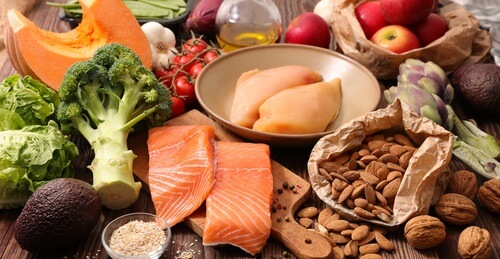
A key component of healthy growing is the nutrition of children. Healthy eating habits include whole grains, fruits, vegetables, nuts and whole grains. Consider how much sugar your child consumes when selecting fruit to add to their diet. As a rule of thumb, fruits should contain at least 80 % water. Similarly, you should avoid adding salt to canned fruit. Canning canned fruit can be a convenient way to add fresh fruits to your child's diet. However, it is best to choose fruit that has minimal sugar or salt.
It doesn't matter how old you are, your role as a parent is vital in providing nutrition for your children. A recent American Dietetic Association Foundation study found that the majority of children considered their parents to be their most important role model in nutrition. They cited that 70% of kids regularly talk with their parents about eating healthy food and body size. They also stressed how important it was to spend quality time together with parents in order foster healthy eating habits.

Although parents can be overwhelmed by the number of options available, the diets of children have changed dramatically in the last few decades. Today, children have access to more nutritious foods. Vegetables are great for everyone, and they can be enjoyed by all ages. Two to three cups of vegetables a day is a good goal. Mixing dark greens with brightly colored vegetables is possible. Some children don't like vegetables. However, you can make it more enjoyable by incorporating them into the child's meals.
Healthy fats are the best way to increase children’s dietary intake. Trans fats and saturated fats are bad for children's health. Vegetable oil (nut oil), nuts, and seafood are all good sources of healthy fats. Limiting your child's intake is the best way to make sure they are only consuming healthy fats. There are many methods to achieve this goal, but keep in mind to be mindful of moderation and to place emphasis on healthy fats over unhealthy ones.
Include fruits as part of your child’s diet. Most fruits are naturally sweet. This means that it has little or no added sugars, which is better for their health. It is also rich in fiber and other nutrients. It is a great choice for a balanced diet. You can add juice and dried fruits to your fresh fruit. These are excellent sources of vitamin C, and antioxidants.

When preparing your child's meals, there are many factors to take into consideration. Remember that you don’t want to force your child to eat. Your goal is to give them everything they need to grow up healthy. High-calorie food should be avoided if it doesn't suit their needs. Don't eat too many foods if your child is not interested in them. A healthy childhood starts with eating well.
FAQ
Why does our weight change as we get older?
How do you determine if your bodyweight is changing?
When there is more muscle mass than fat, weight loss can occur. This means that the amount of calories consumed must exceed the amount of energy used daily. Activity levels are the most common reason for weight loss. Other causes include illness, stress, pregnancy, hormonal imbalances, certain medications, and poor eating habits. If there is more body fat than muscle mass, then weight gain can occur. This happens when people consume more calories than they burn during the day. There are many reasons for this, including overeating and increased physical activity.
The primary reason we lose weight is that we consume less calories than what we burn. Regular exercise increases metabolism, which means that we burn more calories per day. But, this does not mean that we will be thinner. It is important to know if we are losing weight or gaining muscle. If we are burning more calories than what we eat, then we will lose weight. But, if we consume far more calories than what we burn, then we actually store them as fat.
As we grow older, we tend to become slower at moving around and therefore we don't move as much. We also tend not to eat as much food as we used to when we were younger. This is why we tend to gain weight. On the flip side, we tend to have more muscle mass so we look bigger than we really are.
Without weighing yourself each week, there is no way to know how much weight you have lost. There are many ways to determine your weight. You can measure your waist, hips and thighs as well as your arms. Some prefer to use the bathroom scales, others prefer to use tape measures.
For a better track of your progress, try to weigh yourself once per week and measure your waistline once every month. You can also take photos of your self every few months to track how far you've come.
Online measurements of your height and weight can help you determine your body mass. If you are 5'10" tall, and you weigh 180 lbs, then you would probably weigh 180 lbs.
What is the problem with BMI?
BMI is the acronym for Body Mass Index. It measures body fat based upon height and weight. BMI is calculated using the following formula:
Divide the weight in kilograms by the height in meters squared.
The result is expressed as a number from 0 to 25. Scores between 0 and 25 indicate obesity. A score of 18.5 indicates overweight. A score of 23 indicates obesity.
A person of 100 kg with a height of 1.75m will have 22 BMI.
Supplements and herbs can improve immunity
To boost immunity function, herbs and natural remedies are available. Some common examples include garlic, ginger, oregano oil, echinacea, ginkgo biloba, and vitamin C.
These herbal remedies shouldn't be considered a replacement for medical treatment. Side effects may include nausea, diarrhea, stomach cramps (dizziness), headaches, dizziness and stomach cramps.
What are the best 10 foods to eat?
These are the top 10 foods to eat.
-
Avocados
-
Berries
-
Broccoli
-
Cauliflower
-
Eggs
-
Fish
-
Grains
-
Nuts
-
Oats
-
Salmon
What can you do to boost your immune system?
The human body is composed of trillions if not billions of cells. Each cell works together to create organs and tissues that fulfill specific functions. If one cell dies, a new cell takes its place. Hormones, which are chemical signals that allow cells to communicate with one another, enable them to do so. Hormones regulate all bodily processes, from growth and development to metabolism and immunity.
Hormones are chemical substances that glands secrete throughout the body. They circulate through the blood stream and act as messengers to regulate how our bodies function. Some hormones are produced within the body while others are externally manufactured.
Hormone production occurs when hormone-producing cells release their contents into your bloodstream. Once hormones have been released, they travel through the body until reaching their target organ. In some cases, hormones remain active only for a short period of time. Others hormones are more active and have a longer life expectancy. They can still influence the body's functions long after they are eliminated from the bloodstream.
Some hormones can only be produced in large quantities. Others are produced in small amounts.
Some hormones are produced at certain times during life. For example, estrogen can be produced during puberty or pregnancy. Estrogen helps women develop breasts, maintain bone density, and prevent osteoporosis. It also promotes hair growth and keeps skin smooth and soft.
Statistics
- The Dietary Guidelines for Americans recommend keeping added sugar intake below 10% of your daily calorie intake, while the World Health Organization recommends slashing added sugars to 5% or less of your daily calories for optimal health (59Trusted (healthline.com)
- WHO recommends reducing saturated fats to less than 10% of total energy intake; reducing trans-fats to less than 1% of total energy intake; and replacing both saturated fats and trans-fats to unsaturated fats. (who.int)
- nutrients.[17]X Research sourceWhole grains to try include: 100% whole wheat pasta and bread, brown rice, whole grain oats, farro, millet, quinoa, and barley. (wikihow.com)
- In both adults and children, the intake of free sugars should be reduced to less than 10% of total energy intake. (who.int)
External Links
How To
How to Live a Healthful Lifestyle
Healthy lifestyle means you can maintain your weight, health, and fitness. It's a way of living that includes eating well, exercising regularly, getting enough sleep and avoiding harmful substances such as alcohol, caffeine, tobacco, drugs, and so on. A healthy lifestyle helps you stay fit and feel good about yourself. You are also less likely to develop chronic diseases such heart disease and stroke, diabetes or cancer.
This guide will help you live a healthier, more fulfilling life. The introduction is the first part of this project. This explains why healthy living should be encouraged and who it should help. Then I wrote the body paragraphs. They contain various tips on how you can maintain a healthy lifestyle. I then wrote the conclusion. This summarises the article and provides additional resources if desired.
This assignment taught me how to write a concise paragraph. Also, I learned how to organize my ideas into topic sentences and supporting details. My research skills were also improved as I had to search for specific sources and properly cite them. Finally, I learned how to properly use grammar when writing.